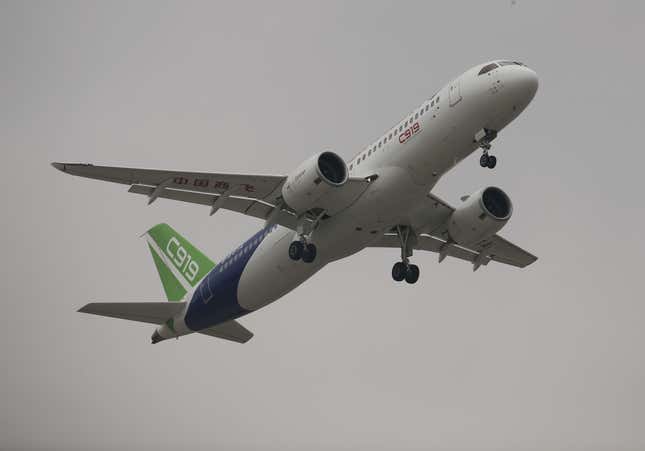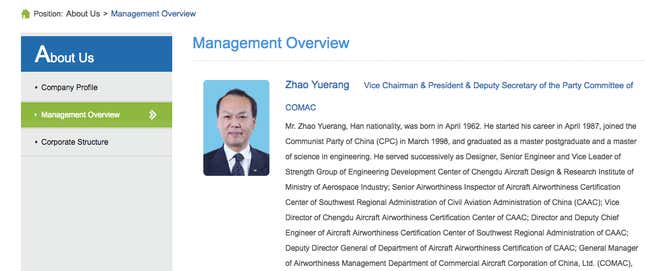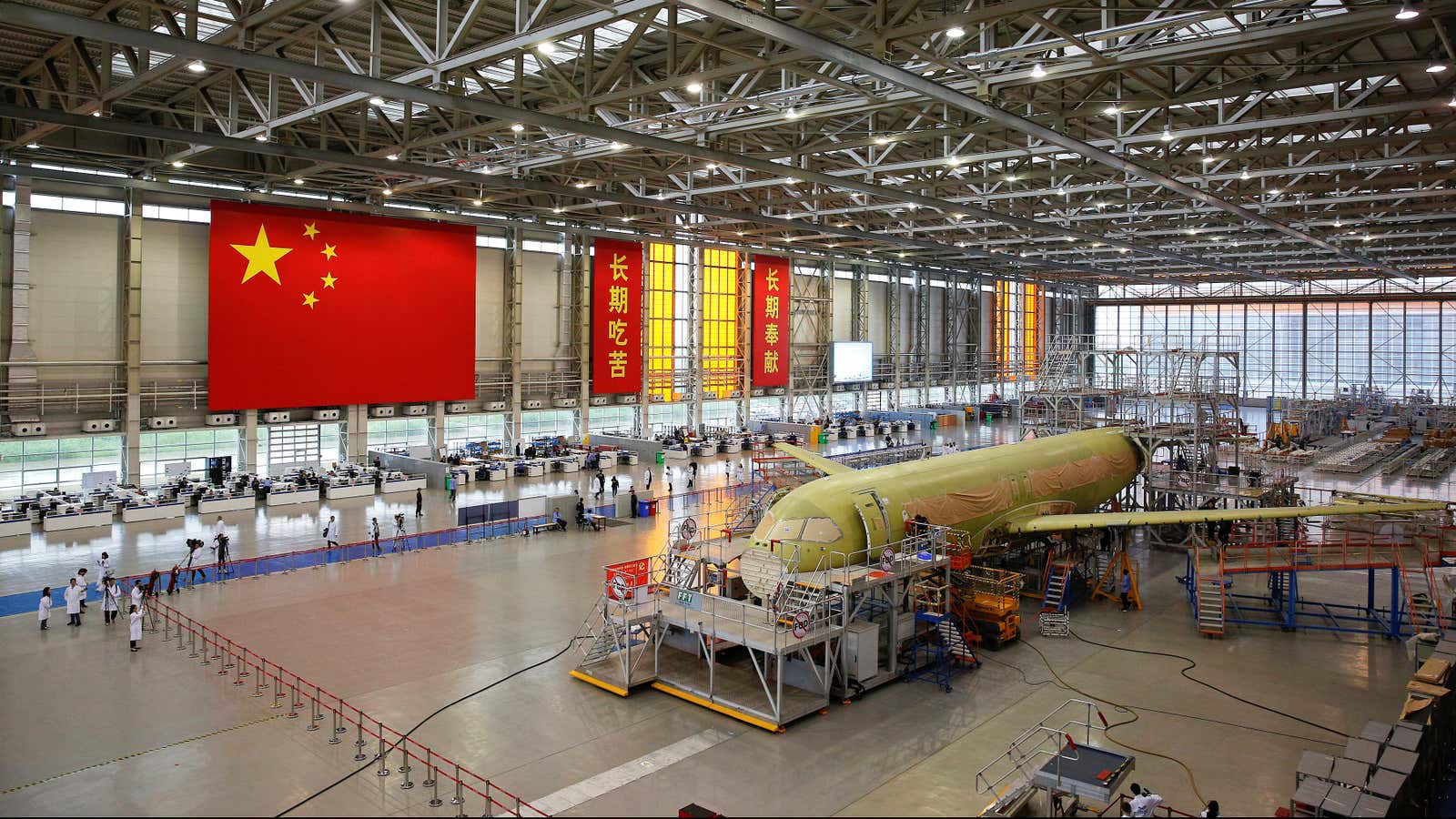Less than 24 hours after a second Boeing 737 Max crashed out of the sky in March, China made a sudden move.
The Civil Aviation Authority of China, the country’s airline regulator, announced that because of its “zero tolerance for safety hazards,” the nearly 100 Boeing 737 Max planes in operation in the country had to stop flying passengers by the evening. It was a notable departure from typical protocol: Not only does a home-country regulator of an aircraft manufacturer normally make the decision about whether to ground its own aircraft, the US Federal Aviation Administration’s judgment tends to be viewed as the gold standard for regulators worldwide. China was effectively saying: We don’t believe the FAA when they say it’s safe. Regardless, its move was quickly followed by groundings across Asia and Europe. Three days later, the US finally followed the rest of the world and grounded the plane.
China’s move was unexpected enough that some industry watchers wondered if politics could be a factor. Yet two tragedies involving a brand-new airplane in five months are also pretty unprecedented in modern flying. In March of 2019, Ethiopian Airlines ET302 crashed a few minutes after taking off, just as a Lion Air flight in Indonesia had done the previous October. In total, the two accidents killed nearly 350 people. The second crash, like the first, has been linked to a new automated system Boeing quietly put on the plane—a system that pilots were not initially told of or trained for—as the US aerospace giant raced to produce an alternative to Airbus’s A320neo. The planes appear set to remain grounded as Boeing works with the FAA on a software fix to make the planes safer.
But while those moves were all made with safety in mind, that doesn’t mean politics isn’t at play here.
Since Henry Kissinger’s secret trip to China in 1971 (on a Boeing 707) to prep for Richard Nixons’s landmark visit that thawed US-China ties, Boeing’s played a role that’s part commercial, part strategic in the US-China relationship. Every Chinese leader to visit the US has toured Boeing’s Seattle facilities, and as the airline industry has grown in China, it’s become a huge customer for Boeing—one of every four planes it makes goes to an operator in China. A quarter of the roughly 370 Max planes in operation at the time of the grounding were flying in China. Boeing also put its first overseas facility in China—a Max completion center—and has spent decades working with China on training, safety, and to help it become a supplier of parts to Boeing’s aircraft.
Still, Boeing is an American company at a time when the US and China are getting along worse than they have in a long while. A pause in rounds of tit-for-tat tariffs as the two countries negotiated on how China could buy more American goods, potentially including more American planes, has ended. Trade tensions between the two countries also center around the Made in China 2025 program—which aims to turn the country into a contender in a number of high-tech industries, including commercial aircraft manufacturing. To that end, the grounding might have been a way for China to signal its regulator’s stringency on safety, thus giving lift to its commercial aviation dreams.
Aerospace prowess requires an extraordinary level of precision and organizational capability, not only when it comes to airplane technology and design, but in coordinating hundreds of suppliers for hundreds of thousands of parts, to say nothing of providing after-sales service and repairs. A robust aerospace industry has become something of a hallmark of just a few highly advanced economies—and China’s leadership wants to be among them.
“There’s a certain number of industries that are so complex in the levels of achievement they require that they’re quite different from being a manufacturing powerhouse as China’s so impressively had to be in the 30 years before,” said James Fallows, author of the 2012 book China Airborne, about the country’s growing aviation industry. “The ambition to join Boeing and Airbus as one of the international aerospace powers would be an interesting test case of this next stage of China’s development.”
“Making Chinese large airlines fly in the blue skies”
The same month the Boeing Max had its first commercial flight, China’s homegrown aerospace contender, Comac, also achieved a major milestone. Its C919 narrowbody, a Chinese answer of sorts to the Boeing 737 Max and Airbus’s A320neo, flew for 78 minutes in its inaugural test flight. It was a proud moment for Comac, one step closer to a goal (rivaling Airbus and Boeing) a former chairman of the state-run company has called a “sacred mission.”
“Entrusted with this sacred mission, and carrying a great dream and passion of making Chinese large airlines fly in the blue skies soon, we have been making unremitting efforts to develop the C919 and ARJ21,” stated Jin Zhuanglong, referring to Comac’s two main aircraft programs.
Short for Commercial Aircraft Corporation of China, Comac was set up by the Chinese government in May 2008, and embarked on the C919 program the same year. The company also makes the ARJ21, a regional jet that can carry a maximum of 90 passengers. The newest program is a twin-aisle widebody, the C929, that it’s working on jointly with Russia. Despite its late start to the game, its government backing gives Comac a better chance of posing a challenge to the duopoly of Airbus and Boeing than a private player.
“Airbus did the same thing, they had a lot of government support to get started,” says Andrew Madar, CEO of aerospace consultancy Aerozon Aviation, who was previously based in China for Boeing, and went on to serve as a key consultant to Comac for more than five years. “In today’s world if you want to start a manufacturing company for aircraft, good luck. It takes billions and billions of capital, the highest skills worldwide… It’s not an easy case for a private company to get into this industry.”

Those programs aren’t the first time China’s tried to build commercial airplanes. In the 1970s, there was the Yun-shi or Y-10, believed to be modeled on Boeing’s 707 aircraft, of which only two were produced. Then in the early 1990s China partnered with McDonnell Douglas to build 40 MD-80s and MD-90s, but in 1996, the company was acquired by Boeing, leading to the termination of the program. Another effort, a 60-seater turboprop known as the Modern Ark 60 or MA60 (paywall), which China exported in the 2000s, became known for numerous safety problems.
Comac’s first commercial aircraft program was actually inherited. The regional jet known as the ARJ21 Xiangfeng—a name that means “soaring phoenix”—began development under a different state-run consortium in 2002, and later was absorbed into Comac. It’s in fairly limited use right now. “The ARJ21, it’s a commercial airplane, but it’s really a Chinese indigenous R&D program… for them to learn how to build an airplane to Western standards,” said aviation researcher David Pritchard, assistant professor in business at SUNY Empire State College. “It’s a learning tool for China and they learned well from it.”
Another way China has learned is through facilities set up by Airbus and Boeing in the country, a quid pro quo for China’s aircraft orders, while Boeing’s pilot training efforts in the country go back to the 1930s. Presentations made by both firms’ executives in China highlight their local ventures, and the parts that each company is taking from local manufacturers. “Boeing doesn’t really advertise this stuff—but they’ve been developing China in all these different ways,” said Pritchard, who’s long tracked China’s aerospace industry. “China’s been gaining expertise in partnerships with Airbus and Boeing.” (China could easily do a reverse of those presentations for its aircraft, which is largely being built from components from European and US suppliers.)
Comac plans to deliver the first C919 in 2021—and to seek US and European certification. It’s still awaiting certification from China’s own regulator—which last year set up an airworthiness office in Comac in a move that appears to be taking a leaf from the FAA’s approach of cooperative rather than adversarial certification, which has come under question in relation to the Max. While industry watchers have said the plane might be dated by the time it comes off the production line, the more pertinent question is perhaps how well the aircraft performs on fuel efficiency. This was, after all a major selling point for the A320neo and an impetus for the development of the Max.
While the Comac claims to have more than 800 orders for the C919 already—it announced in 2010 that China’s three biggest state-run airlines would be its launch customers—analysts say many of these aren’t firm orders, with deposits and a timeline to delivery. They’re also mostly from Chinese carriers and state-run leasing firms, such as AVIC Leasing, whose parent is the state-run aerospace conglomerate Aviation Industry Corporation of China, which has a nearly 40% stake in Comac, according to the US Trade Representative report on the Made in China 2025 program (pdf, p. 110). The leasing arm of GE, whose joint venture with France’s Safran provides the turbofan engines for the plane, has also said it intends to order a number of the jets, then expected to go into service in 2016.
Comac didn’t reply to questions sent via email.
Still, just as aircraft orders have been part of geostrategic ties between China and the US—the year of Richard Nixon’s historic visit, China ordered 10 707s, beginning a turn away from Soviet planes—and between China and Europe, China could follow the same blueprint, especially with countries that are part of its global Belt and Road infrastructure program. Xu Pei, then COMAC’s deputy chief of marketing, told state-run newspaper China Daily in 2017, that Comac was focusing on “three major target markets, which are our home market, Africa, and Southeast Asian countries involved in the Belt and Road Initiative.”
A week after the ET302 crash, Ethiopia’s ambassador to China tweeted photos of himself with demo models of the C919 and C929 at Comac’s Shanghai facility. In April, Ethiopian Airlines Group CEO Tewolde Gebremariam told state-run Xinhua News Agency that it was considering ordering the C919 for its fleet.
“China has been putting all the building blocks together correctly to get where they are today,” said Pritchard. “And today with Embraer being bought out by Boeing and the [Bombardier] C Series going to Airbus, Comac is now a legitimate number-three player in the commercial aircraft industry.”
But there’s still a long road ahead.
Communist party brass and millennials
When Susan Ying, a Boeing veteran, went to Comac as one of the state-run company’s short-term foreign experts, one of the things she noticed about her new colleagues was their relative youth compared with her co-workers at Boeing. They are likely China’s equivalent of millennials, known as the post-90s generation. Many of them would not have seen an entire aircraft product cycle, noted Ying, who spoke about her time at Comac at a panel organized by Washington think-tank CSIS two weeks before the Lion Air crash.
Ying also described Comac’s current chairman He Dongfeng, who took over the role in 2017, as “brilliant” and with “a really hands-on working style.” “If it wasn’t for him, it would have been impossible for me to work over there,” said Ying, now vice president of technology strategy at US electric aircraft startup Ampaire. She didn’t appear optimistic, however, about the ability of the C919 to quickly go into wide use, calling an estimate that it would at best deliver eight planes by 2023 “optimistic.”
Comac’s top management is composed of long-term Communist Party members who’ve come from other government bodies. Compared with the websites of Boeing and Airbus, the biographies strike an odd note, listing their role in Comac’s party committee alongside their Comac titles, and usually beginning with their ethnicity and the year they joined the party. The set up makes the company hierarchical, and prone to working around annual targets, which makes it hard to respond to ideas from within their youthful ranks (it’s a problem more market-oriented companies can have too). “New ideas that can pop up from the bottom or the middle are not pushed up,” said Madar. “This is an issue that they need to figure out for a modern company in the real world.”

And while they bring a lot of experience in regulation and aircraft design, there appears to be little collective experience on the commercial side. Late last year, Comac hired Tan Wangeng, who was general manager at China Southern Airlines, China’s largest state-run carrier, as its deputy general manager, a move seen as preparing the manufacturer to be better attuned to airline needs.
Comac is also more inward looking than is typical for an aircraft manufacturer—when being global needs to be in the DNA of any major aircraft manufacturer. Both Boeing and Airbus have deep relations with airlines worldwide, including in China.
“Aircraft manufacturing is a global business, it’s not a domestic product. So any company that wants to build aircraft has to be extremely smart in cultures and markets worldwide, they have to be inside the system all over the world,” said Madar, who moved to China as Boeing’s director of flight operations there in 1997, working closely with airlines and government agencies for the next 13 years. “Boeing, we went to China 25 years ago and started getting inside the system and learning things… This is what Comac needs to do.”
Without that overseas presence and ability to interface well with carriers and agencies, Comac’s international certification efforts could become stuck.
But then, there’s enormous opportunity within China alone, where Comac can surely count on certification. Chinese domestic air passengers reached 550 million in 2018, according to CAAC, gaining on the 780 million who flew domestically in the US the same year. Airbus has forecast that within two decades, China could have close to 1.8 billion domestic passengers, and will need about 7,400 new aircraft, or about 20% of global demand, while Boeing believes it will need about 7,700.
Pritchard says he expects that in about 15 years, China could be supplying 20% of the market, largely to its own airlines, while Airbus and Boeing split the rest. If Comac’s planes reach a critical mass of use in the China without incident, and go on to gain safety certification in the US and Europe, carriers outside China could become more willing to consider this third option.
“This is a way that Comac can do something important and that is over the years it can show the planes are safe,” said Fallows, who is also a contributor to the Atlantic (Atlantic Media was formerly Quartz’s parent). “There’s no way you can get a record of a decade’s worth of safe operations faster than a decade.”
Rather than creating an immediate opening for Comac, Boeing’s current troubles could make carriers more safety-conscious and cautious, and flyers too. When an aviation major with a century of history is having a crisis of this magnitude, it highlights just how hard it is to get things right—and to keep getting them right—in this industry. What China’s trying to do with aircraft, in the time frame it’s trying to do it in, is harder than most of its other tech ambitions—which include putting people on the moon again.
“Building a successful worldwide commercial airliner is much, much harder than going to the moon because of the ongoing widespread complexity of all sorts—of repair stations, and quadruple redundancy,” Fallows told Quartz. “In a moonshot you can put all your effort on doing all these very difficult things one time. With an aerospace network it has to be done thousands of times per day all around the world and anything that goes wrong can be catastrophic, as we have seen.”
